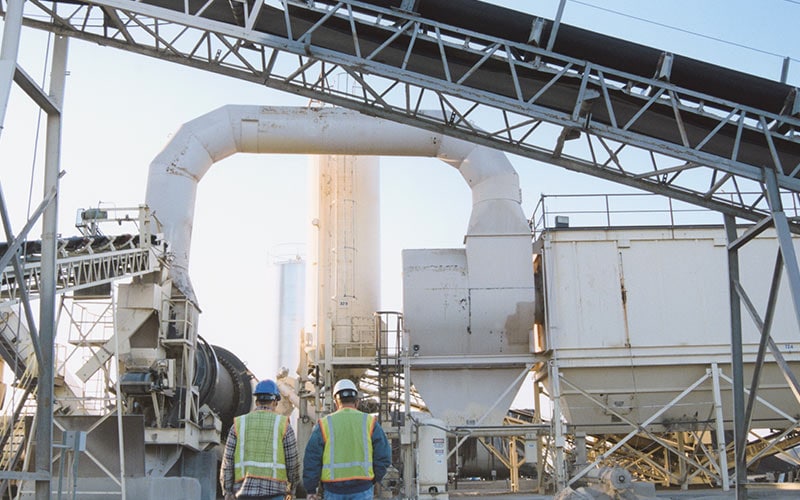
Insights
- The mine-to-market or mining supply chain provides the backbone of several industries and contributed 1.4% to the US GDP in 2023.
- Efficiently mining critical materials is essential to achieve energy transition to reach net zero while delivering financial performance, a CEO priority.
- Mining companies around the world are under pressure over big issues, from human rights and working conditions to environmental degradation.
- One way to address these challenges is through the use of digital technologies.
- Digital technologies such as the industrial internet of things (IIoT), wearables, 5G, and automation have helped improve safety in mines.
The mine-to-market or mining supply chain provides the backbone of several industries. It supplies resources (commodities) such as metals, minerals, and fossil fuels that are required as raw materials or fuel for operation. Mining contributed 1.4% to US GDP in 2023. Efficiently mining critical materials such as lithium, cobalt, and copper is essential to achieve energy transition to reach net zero while delivering financial performance, a CEO priority across industries. At the same time, this supply chain faces significant challenges at both origin and destination, across geographies.
Raw materials at their origin — at the mines — are fraught with problems. Mining companies around the world are under pressure over big issues, from human rights and working conditions to environmental degradation. This is a particular challenge to cobalt mining in Congo, where child labor is widespread in the industry. In Australia, mining companies have had to work with local indigenous people, the traditional owners of the land. Across Asia, from China to India, mining has displaced communities and prompted protest and reputational damage, while environmental damage is a problem for mining companies all over the world.
These pressures, in addition to issues during transit and fuel price volatility, make sourcing those raw materials a major concern for global companies: more than 70% of these highlighted that raw materials and their escalating cost were the number one supply chain threat for 2023. More recently, in its outlook for supply chains in 2025, the International Trade Council highlighted that the focus on resilience and diversification has led to higher costs, warning that these higher costs will fuel inflation.
Resources businesses face specific challenges as players in an industry that is highly regulated, tremendously capital-intensive, and dominated by a few key players that develop most of the supply chain ecosystem — be it in mining, agriculture, material sciences, or chemicals. Those dominant players largely define the direction the industry takes, and this has led to some digital and technology challenges.
Due to the nature of materials that come in from natural sources, supply chain challenges in the industry have been fraught with macro factors of physical and digital infrastructure issues and challenges. These materials are available in limited quantity in remote locations and need complicated processes to mine them. This is predominant in the ongoing decade with the advent of computing, telecommunication technologies and deeper investments in wireless and fiber optic infrastructures globally.
Challenges in transit
The traditional focus of supply chain management has been on speed and affordability, with sustainability as a recent focus. But the Covid-19 pandemic, and more recent disruptions such as the Ukraine and Israel-Hamas war, the Suez Canal blockage, and the Baltimore bridge accident, brought the focus to supply chain resilience, the ability to spring back to normalcy from unforeseen events.
The chip shortage that followed the pandemic brought out the lack of upstream visibility into timely supply of parts for large manufacturers, beyond their tier-1 suppliers. Control towers, a central location to consolidate data across the supply chain to feed into decision-making, have become popular to provide end-to-end supply chain visibility for an enterprise.
Addressing challenges in the mines
One way to address these challenges is through the use of digital technologies. Several policy moves and digital initiatives are addressing the challenges in mines. The Combatting Child Labor in the Democratic Republic of the Congo’s Cobalt Industry (COTECCO) project aims to address human exploitation for cobalt mining in Congo by increasing transparency and monitoring working conditions and child labor across the cobalt supply chain. It is working with the Congo government to develop a monitoring system, as well as working to establish workers’ rights centers to provide information and support to those in the mining sector.
As well as policy initiatives, digital technologies such as blockchain applications to track the source of materials and mining practices can also help deter exploitation and child labor. Digital solutions can mitigate shortages: for example, when the automotive industry faced a chip shortage, Tesla managed it by rewriting its vehicles’ software to work with available chips.
Mining has been one of the most dangerous industries, although safety measures have improved recently. In the US, fatal injuries in the mining, quarrying, and oil and gas extraction sectors fell from above 100 (127 in 2019) in previous years to below 100 in 2023. Digital technologies such as the industrial internet of things (IIoT), wearables, 5G, and automation have helped improve safety in mines (Figure 1).
For example, mining companies are using IIoT sensors to detect dangerous situations such as a gas leak. Additionally, wearable devices are used to monitor health metrics, personal protective equipment, and training miners for safe practices and emergency responses. Vale’s usage of augmented reality/virtual reality (AR/VR) is an example of immersive experiences for miner safety training. Infrastructure is also key: private 5G networks help with real-time communication, with edge computing used for local decisions such as a go/no-go decision for a tool change in remote locations where connectivity is a challenge. Vale has partnered with Nokia to implement a private 5G network in its mines for what is called “cognitive monitoring network service.”
Digital technologies are also helping with the mining industry’s sustainability efforts. The sector accounts for between 2% and 3% of global carbon emissions, and companies have announced initiatives such as using electric haul vehicles and renewable energy for mining operations to reduce emissions.
Figure 1. Technologies that drive safe mining sector operations
Source: Infosys
Human rights issues are also being addressed with digital technologies to consider the impact of displacement on communities and how to mitigate that. For example, mobile phones help displaced communities interact among their members and with the outside world. Additionally, digital platforms along with AI are also being used, together with offering fair compensation for digital work — tasks that can be performed in a virtual environment such as labelling of information, content marketing, procurement. Digital platforms can help reduce information asymmetry between employers and refugees, to assure them a fair pay befitting the work.
Control towers are an approach to providing visibility across the supply chain (Figure 2). They consolidate data from multiple business units, factories, information systems, and platforms into a unified view for decision-making. Technologies such as IoT and RFID gather information from the location of shipments to key parameters and feed the information to a central dashboard for decision-making.

Figure 2. Mining supply chain control tower provides end-to-end visibility
Source: Infosys
Natural resources and materials have witnessed a dramatic increase in demand due to new business models and goals in the energy transition era.
Natural resources and materials sectors have witnessed a dramatic increase in demand due to rapidly changing business models and goals in the era of energy transition and sustainability. While electrification and sustainability drive the bulk of the demand for energy transition materials today, tomorrow’s challenges and needs will focus on the need for supply chains to be cognitive and responsive to the external environment, predictable and responsive (Figure 3).
Figure 3. Energy transition materials: extract-to-retire supply chain and demand channels
Source: Infosys
Supply chain resilience can be looked at from two broad perspectives — proactive action before a disruption happens, and corrective action after the disruption. Proactive action is to continuously monitor the supply chain for the status of shipments and key signals. While physical infrastructures do largely depend on macro factors such as policies, government actions, economy etc., digital infrastructures play an important role in timely information flow for proactive action. And eventually, when an unforeseen event occurs, corrective action needs to be taken. The International Institute for Management Development identifies five pillars of supply chain resilience: addressing bottlenecks to deal with vulnerabilities, management culture to support resilience initiatives, procurement with diversification, operations in the form of safety stock, and demand and visibility including that of customers and partners.
Areas that will define investment in supply chain resilience
- Supply chain maps for the big picture: A supply chain map is a visual representation of all stakeholders involved, with both the physical flow of goods between them and, more importantly, the information flow. These maps can help identify weak links in the chain. Newmont, for example, has used a cloud-based GIS application to map drone workflow for monitoring and analysis, reclamation reporting, and improvement of health and safety initiatives.
- Alternative suppliers for added resilience: In the case of raw materials, some approaches to manage disruptions are to evaluate alternate suppliers and have a list ready for diversification and localization and conduct research to identify alternate materials when there is a shortage. For example, sodium-ion, magnesium-based, and solid-state batteries are alternates to the lithium-ion batteries, with more research to be carried out for their scalability and performance.
- AI deployment for decision-making in mines: AI and autonomous systems are crucial to improve yield, address workforce shortages, and enable timely decisions without human intervention, leading to safer, more productive operations. Generative AI can be used to simulate scenarios to conduct a stress test and identify the weakest link in the supply chain.
- Single ERP usage for a strong foundational data platform: Traditional resource companies such as miners are often still on home-grown, legacy IT systems due to the uniqueness of the industry. Upgrading and expanding to a combination of industry best practice enterprise resource planning (ERP) systems is an approach to extend the ERP beyond the enterprise, exposing the company to demand patterns of the client for quick action. Tesla’s Warp is a home-grown ERP system to which its customers also have limited access for closed-loop, bidirectional information flow.
- Businesses of the future: Supply chain investments have traditionally targeted operational ease for cost efficiency. Mining businesses should increase their focus on new customer acquisition, and a higher spend on customer acquisition will bring more resilience as they expand into areas such as energy storage.
- Participation in industrial consortiums and marketplaces: Competitors often need to collaborate: One such example that is planned is in the European auto industry to face the competition from its American and Chinese counterparts — an equivalent for Airbus in the automotive industry. EURELCO is a mining consortium in Europe that supports technological, legal, social, economic, environmental, and organizational innovation for landfill mining.
- Reverse logistics: Given the forecast demand-supply gap for key materials, one risk mitigation manufacturers can do is to invest in their reverse logistics for circularity of end-of-life materials. Copper and gold mining company Antofagasta, for example, recovers steel from discarded mine haulage truck tires for recycling into grinding balls at its Los Pelambres mine.
“Different nations are investing in distinct supply chain capabilities, like localizing or reshoring semiconductor production, yet there is a necessity to safeguard critical mineral supply chains stretched across diverse geographies,” says Dr. Mukesh Kumar, University of Cambridge.
The mining sector is uniquely positioned at the very start of the value chain for several industries, leaving limited options to diversify
The mining sector and resources overall are uniquely positioned at the very start of the value chain for several industries. That leaves them with limited options to diversify their sources of supply, such as the mines. That said, it also leaves the decisions within the control of the mining companies. Decisions taken by mining business leaders in the short term will have a major impact on the long term due to the waves of sustainability, digital transformation, and supply chain management happening at the same time.








